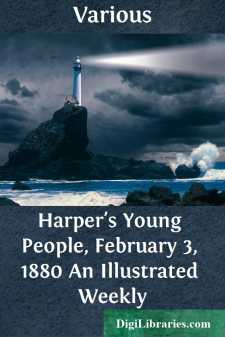Categories
- Antiques & Collectibles 13
- Architecture 36
- Art 48
- Bibles 22
- Biography & Autobiography 813
- Body, Mind & Spirit 142
- Business & Economics 28
- Children's Books 17
- Children's Fiction 14
- Computers 4
- Cooking 94
- Crafts & Hobbies 4
- Drama 346
- Education 46
- Family & Relationships 57
- Fiction 11829
- Games 19
- Gardening 17
- Health & Fitness 34
- History 1377
- House & Home 1
- Humor 147
- Juvenile Fiction 1873
- Juvenile Nonfiction 202
- Language Arts & Disciplines 88
- Law 16
- Literary Collections 686
- Literary Criticism 179
- Mathematics 13
- Medical 41
- Music 40
- Nature 179
- Non-Classifiable 1768
- Performing Arts 7
- Periodicals 1453
- Philosophy 64
- Photography 2
- Poetry 896
- Political Science 203
- Psychology 42
- Reference 154
- Religion 513
- Science 126
- Self-Help 84
- Social Science 81
- Sports & Recreation 34
- Study Aids 3
- Technology & Engineering 59
- Transportation 23
- Travel 463
- True Crime 29
Harper's Young People, February 3, 1880 An Illustrated Weekly
by: Various
Categories:
Description:
Excerpt
THE HOUSE-SPARROW.
The English house-sparrow, a pert, daring little bird, which is seen in crowds in almost all cities of the Northern United States, was first brought to this country about twenty years ago. It is said the first specimens were liberated in Portland, Maine, where they immediately made themselves at home, and began nest-building and worm-catching as eagerly as when in their native air. Others were soon brought to New York city, and set free in the parks. At that time New York, Brooklyn, and other cities were suffering from a terrible visitor, the loathsome measuring-worm, which made its appearance just as the trees had become lovely with fresh spring green. It infested the streets in armies, hung in horrible webs and festoons from the branches of the shade trees, and ruined the beauty and comfort of the city during the pleasantest season of the whole year. About the first of July, when the worm finished its work, the trees appeared stripped and bare, as if scathed by fire, and a second budding resulted only in scanty foliage late in the season. A month after the worm disappeared, its moth—a small white creature, pretty enough except for its connections—fluttered by thousands through the city, depositing its eggs for the worm of another year. Desperate measures seemed necessary to stop this nuisance, and the question of cutting down all the trees was seriously considered. But relief was at hand. A gentleman, an Englishman, proposed an importation of sparrows, and soon hundreds of these brown-coated little fellows were set loose in different cities. They at once became public pets. Little houses were nailed up on trees and balconies for them to nest in, sidewalks and window-sills were covered with crumbs for their breakfast, and boys were forbidden to stone them or molest them in any way.
Now although the sparrow is very willing to feed on bread-crumbs and seeds, and save itself the trouble of hunting for its dinner, by a wise provision of nature the little ones, until they are fully fledged, can eat only worms and small flies and bugs. As the sparrows have three or four broods during the warm weather, they always have little ones to feed at the very season when worms and other insects destructive to vegetation are the most plentiful. An English naturalist states that in watching a pair of sparrows feeding their little ones, he saw them bring food to the nest from thirty to forty times every day, and each time from two to six caterpillars or worms were brought. It is easy to see from this estimate how quickly the tree worms would disappear, as proved to be the case in the cities where the sparrows were set free.
A very few years after they were introduced not a worm was to be seen. The trees now grow undisturbed in their leafy beauty all through the summer, and many children will scarcely remember the time when their mothers went about the streets where shade trees grew carrying open umbrellas in sunny days and starry evenings to protect themselves from the constantly dropping worms....












